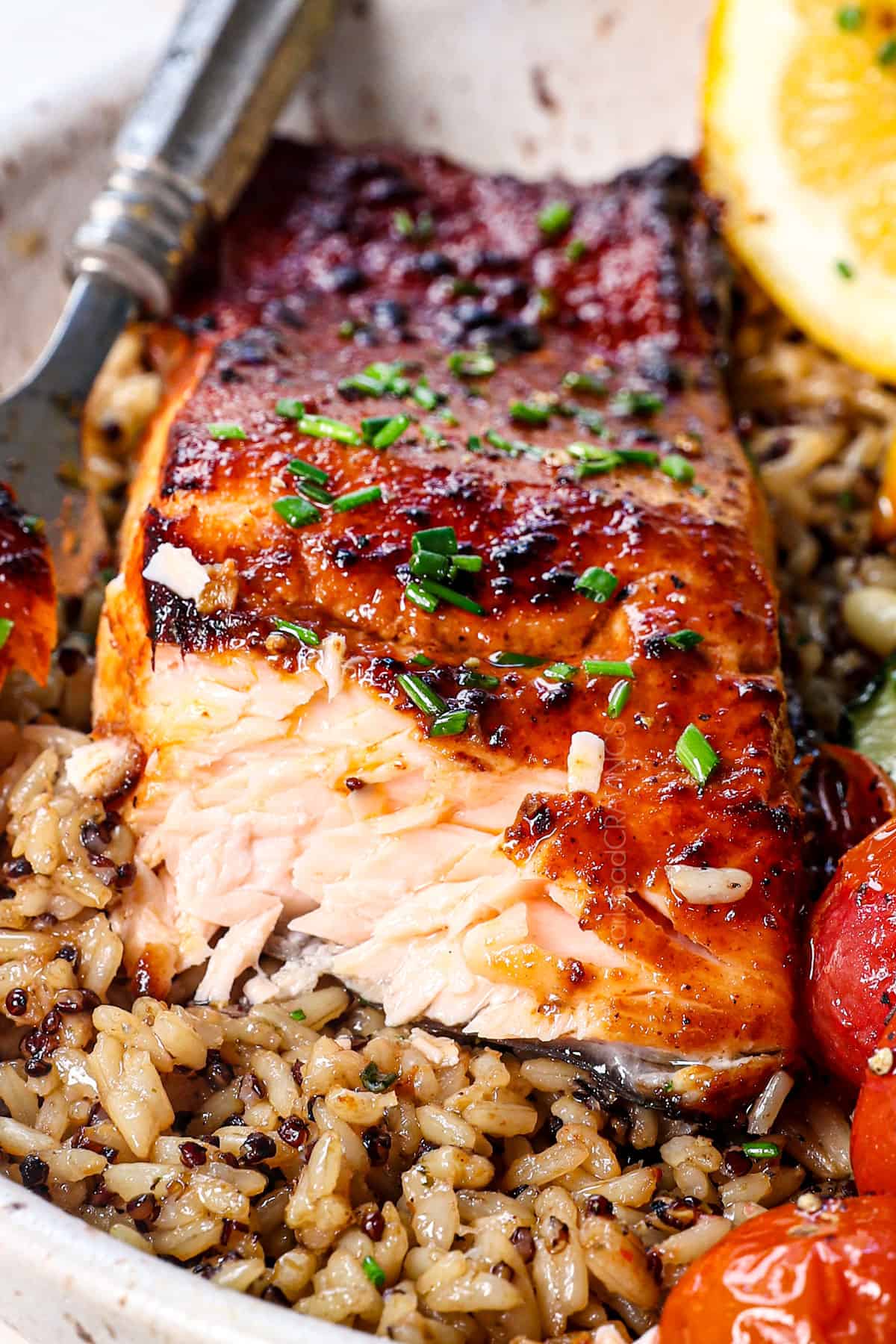Air Fried Salmon

To season salmon for the air fryer, start by patting the fillets dry with paper towels—this helps the seasoning stick and prevents steaming. Lightly brush the salmon with olive oil to lock in moisture and promote browning.
A good salmon seasoning should hit all the key flavor elements: salt, sugar, acid, and spice. You can use a simple Cajun-inspired dry rub made with smoked paprika, garlic powder, onion powder, chili powder, black pepper, and salt for a bold, savory flavor.
Or opt for a glaze by mixing Dijon mustard, maple syrup (or honey), soy sauce, and a splash of balsamic vinegar for a sweet, tangy, and umami-packed coating. Apply your seasoning or glaze evenly over the top (no need to season the skin side), and let the salmon rest for 5–10 minutes before cooking to allow the flavors to settle in. This method ensures that every bite of your air-fried salmon is flavorful, juicy, and perfectly balanced.
No, you do have to flip salmon in the air fryer. Air fryers circulate hot air around the food, so both sides cook evenly without the need to turn it. In fact, keeping the helps protect the delicate flesh, keeps the fillet moist, and prevents it from falling apart. Flipping is more likely to break the fillet or cause sticking—so skip it and let the air fryer do the work for you!
To tell when salmon is done in an air fryer, check that the internal temperature has reached in the thickest part of the fillet—this allows it to finish cooking off heat to a juicy 140–145°F.
The salmon should easily flake with a fork, but still look slightly translucent in the center (not raw). Visually, the flesh should turn from a deeper, glossy orange to a lighter opaque pink. If the salmon is dry, chalky, or curling at the edges, it’s likely overcooked—so it’s best to rely on a meat thermometer for perfect results every time.
Yes, you can air fry frozen salmon, and it turns out surprisingly well! The texture may be slightly softer than fresh, but it’s still juicy, flavorful, and perfect for a fast, no-fuss meal.
You don’t need to thaw it first—rinse off any ice crystals, pat it dry, and plan on pausing the air frying once the exterior is thawed to apply any seasonings or wet rubs. Air fry at , depending on thickness, until the internal temperature reaches 135°F. For best results, add a minute or two if the fillets are especially thick, and always check doneness with a thermometer.
What temp to air fry salmon?
Air frying salmon at 400°F is ideal because it strikes the perfect balance between quick cooking and caramelized, flavorful results. The high heat helps the exterior develop a lightly crisp, golden crust while locking in moisture so the inside stays tender and juicy. It also mimics the searing effect of pan-roasting or broiling—without needing extra oil or a hot oven.
At lower temperatures, salmon can dry out from overexposure to heat or develop a mushy texture, while higher temps risk burning the glaze or seasoning before the center is cooked. With 400°F, you get reliably even cooking in about 7–10 minutes, making it both efficient and delicious.

FIND ME ON PINTEREST FOR MORE GREAT RECIPES! I AM ALWAYS PINNING :)!
©Carlsbad Cravings by CarlsbadCravings.com
You can now create an account on our site and save your favorite recipes all in one place!
Serving Ideas
- Parsley or chives (optional)
- Avocado crema (optional)
- Corn salsa (optional)
- Pineapple Salsa (optional)
- Mango Salsa (optional)
Set the air fryer to 400°F using the Air Fryer setting to preheat. Pat your salmon filets dry with a paper towel, then lightly brush or spray with olive oil.
Whisk all the remaining ingredients together in a small bowl to create a wet rub. Brush it on the tops and sides of the salmon. Lightly spritz the salmon with olive oil if you have a sprayer (this is my FAV).
Spray the air fryer basket with nonstick cooking spray. Arrange the salmon filets in a single layer without touching, skin-side down (you may need to work in batches). Air fry until the internal temperature reaches 135°F, about 7 to 10 minutes, depending on the thickness.
Serve with a squeeze of fresh lemon juice, freshly cracked salt as desired, or any of the suggested serving options. Enjoy!
*Increase maple to 2 tablespoons for a maple forward/sweeter taste
Did You Make This Recipe?
Tag @CarlsbadCravings and Use #CarlsbadCravngs
Leave a Review, I Always Love Hearing From You!











